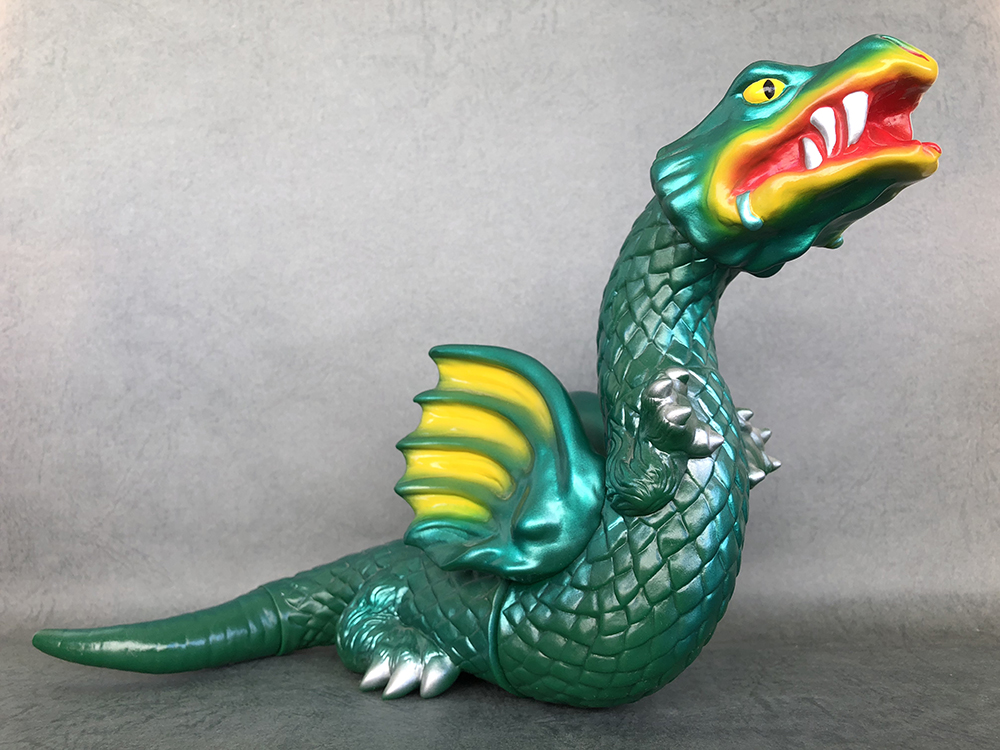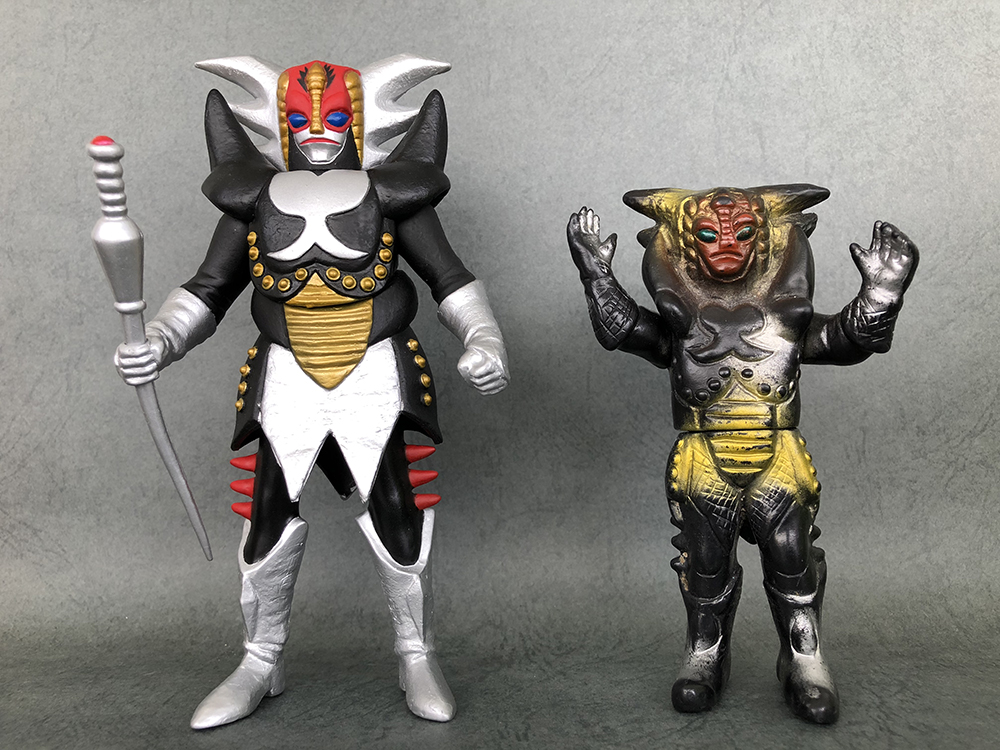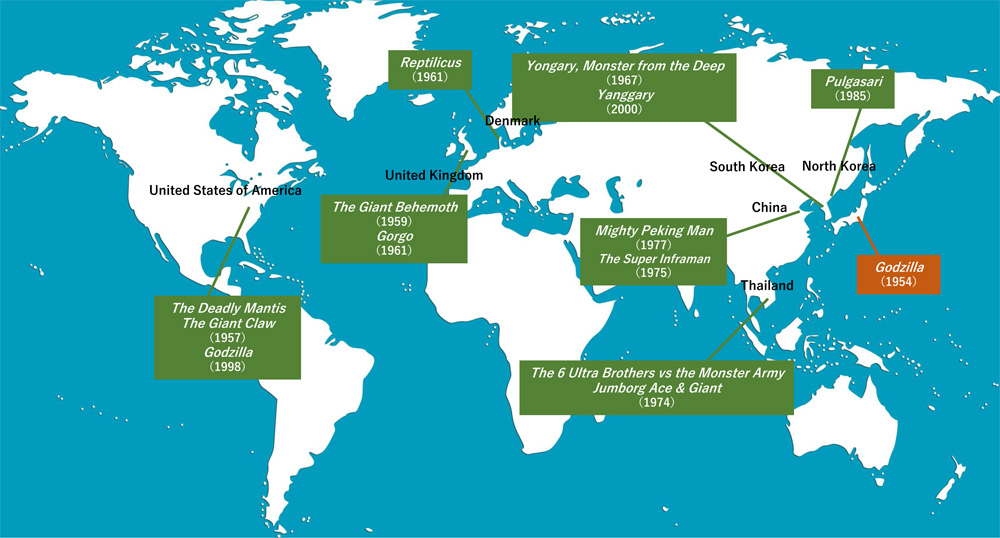How did “Kaiju,” derived from Japan’s Godzilla, spread across the world? How did it spread in the United States, the homeland of King Kong that started everything? What about the United Kingdom where Thunderbirds was created and Asian countries geographically close from Japan? Let’s look at special effects films in those countries. Kaiju have certainly left their giant marks abroad...!
 Reptilicus from Reptilicus (1961). A Japanese manufacturer has produced and launched the figure recently. Once made into a retro PVC figure, a monster created overseas looks little different from Japanese Kaiju.
Reptilicus from Reptilicus (1961). A Japanese manufacturer has produced and launched the figure recently. Once made into a retro PVC figure, a monster created overseas looks little different from Japanese Kaiju.
*All the figures shown in the photographs are the author’s personal properties.
Godzilla appears in the U.S. and Europe.
In the last article, I defined “Kaiju,” considering how people in other countries would see Japanese Kaiju. The requirements are as follows.
・ Kaiju appears in stories set in the present time, the near future or the recent past.
・ Kaiju has a gigantic body beyond comparison with any life form that exists.
・ Kaiju appears in a big city and destroys buildings with its huge body or supernatural powers.
What it comes down to is Kaiju refers to monsters that reflect the influence of Godzilla (1954). Now, I will look at how they have fulfilled needs of the world. For example, in the former Soviet Union’s fantasy film Ilya Muromets (1956), a fascinating three-headed dragon (*1) on which the design of King Ghidorah is based appears. The dragon is not counted as Kaiju as it does not meet the requirements.
By contrast, what matches the requirements perfectly is the American-made creature in The Giant Claw (1957). A condor-like space monster that looks as big as 300 meters in length goes on the rampage in the face of attacks by the U.S. forces. Although it is often made fun of because of its manga-ish humorous look, the gigantic appearance perching on the Empire State Building with its wings spread is a must-see. It is as impressive as Radon in Sora no Daikaiju Radon (Giant monster of the sky, Radon) (1956), which is hailed as a masterpiece. It can even be more Kaiju than Radon in the sense that most weapons do not work on it. The first Radon was seriously injured by the Self-Defense Forces’ missile attacks. When it comes to overwhelming the U.S. forces, the mantis in The Deadly Mantis (1957) is another memorable character. It is about an ancient mantis awakened by a volcano. It looks just like a praying mantis (*2). However, it somehow has a great and bizarre impact partly because of its perfect design. Reptilicus in Reptilicus (1961), which is said to be the only Kaiju film ever made in Denmark, is tough. The creature repels attacks by tank corps. Even if destroyed into pieces, it regenerates from a small piece. Monsters created overseas tend to be vulnerable to military attacks. However, quite a few monsters are tough (*3) like those examples. Those three monsters were not played by suit actors nor created by stop motion animation. They were moved by physical effects, being operated just like a marionette or a puppet.
Next, let’s take a look at the United Kingdom. The U.K. is a major special effects film and television maker, producing the Thunderbirds series and the Doctor Who series. However, real Kaiju films are limited in number. The Giant Behemoth (1959) was produced by a powerful line-up of crew. The film was directed by Eugène Lourié, who also wrote the screenplay. Lourié was the director of The Beast from 20,000 Fathoms that gave great inspiration for Godzilla. The special effects were created by Willis O’Brien, who was in charge of special effects of King Kong (1933). A dinosaur of the family Paleosaurus resurrected by nuclear testing landed London and spread radiation. The storyline strongly suggested that the film could be a self-remake of The Beast from 20,000 Fathoms. However, some scenes, such as the monster breathing out radiation and a first foreshadowing incident occurring in a rural fishing village, seemed to be gotten from Godzilla. Lourié also directed Gorgo (1961) using suit actors and miniature sets just like Japanese films. The film was supposed to be produced jointly with Japan and there was also a plan to set it in Tokyo. Eventually, London was chosen (*4). Ogra, a legendary sea monster, was captured off the coast of Ireland and sold to a circus in London. The monster was named Gorgo and put on show. It turned out that Gorgo was a still growing offspring. The mother of Gorgo in a rage was coming close to Britain to get back her child... Although the storyline was influenced by King Kong, the idea of monster mother and child made the film unique (*5). The image synthesis and the miniature sets are high in quality. This is foremost among foreign Kaiju films. The mother monster is 60 meters tall. It is tough and invulnerable to the attacks by the British forces. This is Kaiju. Some of the films mentioned above (*6) cannot be definitely said to be influenced by Godzilla but Gorgo sure is.
From Japan to Asia
What about Kaiju films in Asia? Many Kaiju films have been produced with special effects crew invited from Japan. Among them is Yongary, Monster from the Deep (1967) produced in Korea with the cooperation of crew of the Showa Gamera series (*7). The underground monster Yongary awakened by nuclear testing ravaged Seoul with flame radiation from the mouth and light beams from the horns. Yongary rampaged in the face of an all-out attack by the Korean forces, but it turned out that it was vulnerable to ammonia. Finally, sprayed with a special ammonia solution, Yongary scratched himself and bled from bowels and died. The horrible death became legendary among special effects enthusiasts. Some might feel a cultural gap about such excessively brutal depictions. Still, the design of Yongary, created by Ekisu Production in charge of art design for the Showa Gamera series and the Kamen Rider series, is simple and powerful. This is vintage Kaiju. The storyline sticks to the basics of Kaiju films and it is little strange to the eyes of Japanese audience. It must have been a hit in Korea. It was remade in 2000 as Yanggary. This film was a coproduction with the U.S., not Japan.
Shaw Brothers, a leading film production company in Hong Kong, produced Mighty Peking Man (1977), inviting Sadamasa Arikawa, the number-one protégé of Eiji Tsuburaya. Unlike the well-known fossil hominid Peking Man, this Peking Man was a 25-meter tall giant apeman awakened in the Himalayan hinterland. To put plainly, it was produced as a rival to the remade King Kong (1976). The Peking Man was designed by Keizo Murase who used to work for Ekisu Production. It was extremely Japanesestyle Kaiju including the way it rampaged in Hong Kong. Another special effects film produced by Shaw Brothers is The Super Inframan (1975). As it was not a Kaiju film, but rather like the Kamen Rider series or other human-sized henshin (transformation) hero TV shows, I won’t go into details. The design was created by Ekisu Production, the original designer of the henshin heroes. If not limited to Kaiju films, Hong Kong special effects films are too numerous to mention. It will take forever and so let’s move onto Thailand.
 The alien invader Antigone from Jumborg Ace (1973) and Jumborg Ace & Giant (1974). The PVC figure on the left was made in Thailand. The product lineup included many other Kaiju and alien characters from those films. In Japan, PVC figures of only two characters including the one on the right were launched. There was an apparent difference in enthusiasm between Thailand and Japan.
The alien invader Antigone from Jumborg Ace (1973) and Jumborg Ace & Giant (1974). The PVC figure on the left was made in Thailand. The product lineup included many other Kaiju and alien characters from those films. In Japan, PVC figures of only two characters including the one on the right were launched. There was an apparent difference in enthusiasm between Thailand and Japan.
Well-known Thai special effects films are mostly the works of Chaiyo Productions founded by Sompote Saengduenchai, who is said to learn special effects with Eiji Tsuburaya. A particularly famous work is The 6 Ultra Brothers vs the Monster Army (1974). A boy killed by Buddha thieves was reincarnated as Hanuman, a white monkey in Indian myths. He, together with the Ultra brothers, combated the monster army attacking a rocket launch site. Many crew members of the original Ultraman series participated. Just as Yongary, Monster from the Deep, the way the monsters are killed is beyond description. It is especially shocking as they are familiar Kaiju characters. Another film co-produced by Chaiyo Productions and Tsuburaya Productions is Jumborg Ace & Giant, not released in Japan. It is the theatrical version of Japanese henshin hero TV series Jumborg Ace, also aired in Thailand. Life was given to the god statues of Wat Pho (the temple of the reclining Buddha) and Wat Arun (the temple of dawn). They were named Giant. Giant teamed up with Jumborg Ace and fought the monster army. As the relationship between Tsuburaya Productions and Chaiyo Productions has deteriorated, those films are not easily available.
Finally, I will talk about a North Korean monster film. It is Pulgasari (1985) produced under the direction of General Secretary Kim Jong-il, a movie buff. This film does not meet the requirements above as it is a costume drama set at the end of the Goryeo Dynasty. However, it is a real Kaiju film produced with full cooperation of Toho special effects crew of the Godzilla series. Pulgasari was designed and created by Nobuyuki Yasumaru, the then chief modeler of Toho and played by Kenpachiro Satsuma, well-known as a Godzilla suit actor. In that sense, Pulgasari can be said to inherit the genes of Godzilla. However, the film was shelved because director Sang-ok Shin sought asylum in the United States immediately after the film was completed (*8). The ban was later lifted. It was theatrically released, though on a small scale, in Japan in 1998 just when the Hollywood version of Godzilla was released and Kaiju was becoming popular worldwide. In the next part, I will talk about Kaiju characters awakened all at once across the world in response to the return of the Kaiju king.
 Kaiju films produced after the release of Godzilla, King of the Monsters! (1956) was announced
Kaiju films produced after the release of Godzilla, King of the Monsters! (1956) was announced
(notes)
*1
A 20-meter tall full-scale model was created and a flamethrower was placed in its mouth. The scene of blowing flames to the crowd using the model was spectacular. In eastern and central Europe, multiple-headed dragons seem popular. Hydra, multiple-headed snake in the Greek myth, is Ghidorah in Russian spelling.
*2
As it looks just like the actual insect, it is unlike Kaiju. Similarly, Kamacuras appearing in Kaiju-to no Kessen: Godzilla no Musuko (Son of Godzilla) (1967) closely resembles a real praying mantis except for the lance-shaped front legs. The deadly mantis is more elaborate in design than Kamacuras but Kamacuras is more delicate in movement.
*3
By contrast, it is not uncommon for Japanese Kaiju characters to be badly wounded or killed by military attacks. The notion that missile attacks are very much like a pea-shooter for Kaiju seems to have taken root after the Ultraman series.
*4
Australia and France were also said to be considered as the setting of the film. Finally, London was chosen because it boasted many structures worth destroying, such as Big Ben and London Bridge. Destroying famous spots is one of the best parts of Kaiju films.
*5
The story of Daikyoju Gappa (Gappa the Triphibian Monster) (1967) produced later by Nikkatsu was apparently based on that film. The idea of transporting a life-size Gorgo on a tractor-trailer was used in the episode about mount dragon of Spectreman (1971) and in Chiisaki Yusha-tachi – Gamera (Gamera the Brave) (2006).
*6
Other British Kaiju films include X the Unknown (1956) and Konga (1961). The former features a blob-like creature, pioneering this type of monster films including The Blob (1958). The latter features a giant monkey-like monster suggestive of King Kong. I didn’t mention those films as they seemed independent of the influence of Japanese Kaiju films.
*7
A total 12 films have been produced as the Gamera series. Among them, eight films produced by Daiei are called the Showa Gamera series: Gamera (1965), Gamera vs Barugon (1966), Gamera vs Gyaos (1967), Gamera vs Viras (1968), Gamera vs Guiron (1969), Gamera vs Jiger (1970), Gamera vs Zigra (1971) and Gamera: Super Monster (1980). Those films gained popularity for the death matches between Gamera and opponent Kaiju in which Gamera lost a battle to win a war, as the saying goes. Gamera got injured but defeated the opponents.
*8
After moving to Hollywood, Sang-ok Shin participated as a writer in the production of the fantasy film Galgameth (1996), a loose remake of that film. No Japanese crew participated in the production. However, Galgameth was played by a suit actor.
| ◀ No. 1 | No. 3 ▶ |











